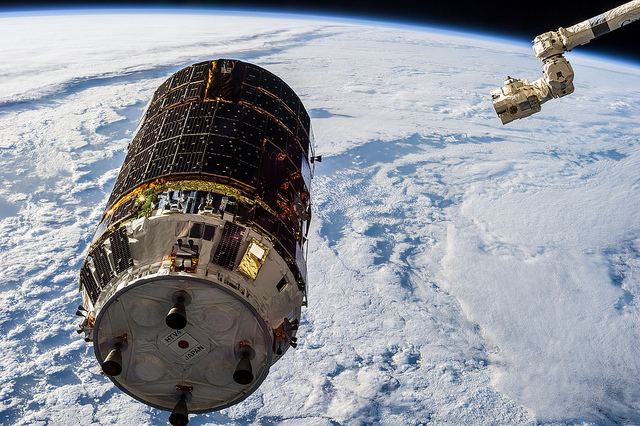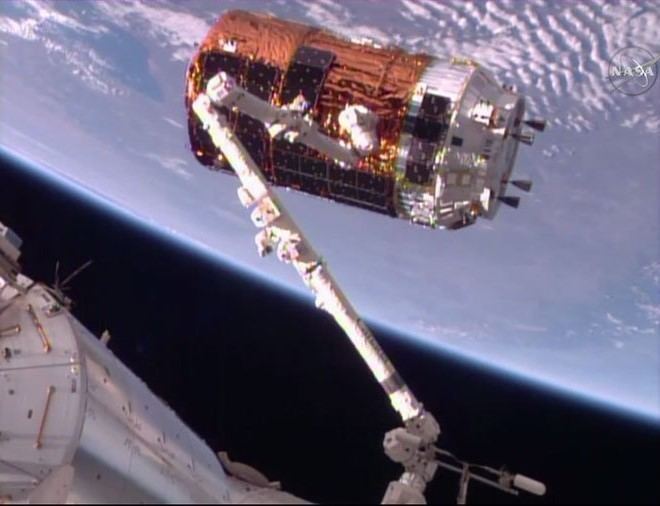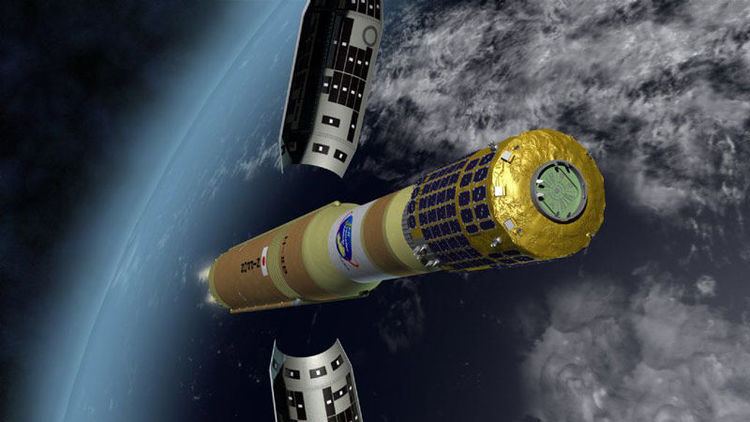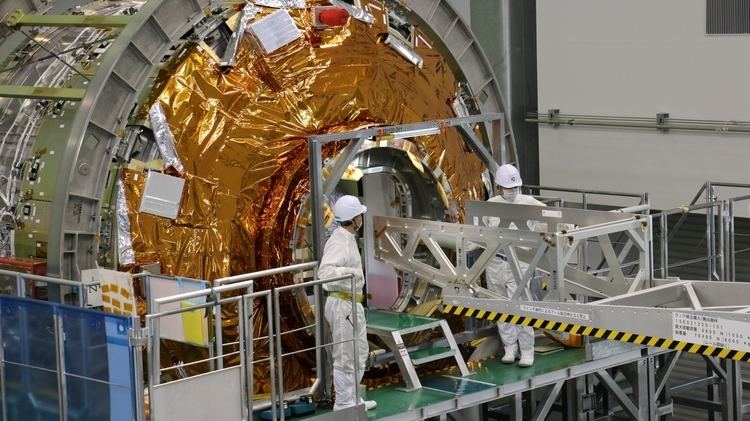Mission type ISS resupply Disposal deorbited Launch date 9 December 2016 | Contractor Mitsubishi Inclination 51.6° | |
 | ||
Decay date 15:06, 5 February 2017 (2017-02-05T15:06) Similar H‑II Transfer Vehicle, Kounotori 4, Progress MS‑04, Kounotori 5, JCSAT‑15 | ||
Kounotori 6 (こうのとり6号機), also known as HTV-6, is the sixth flight of the H-II Transfer Vehicle, an unmanned cargo spacecraft launched to resupply the International Space Station. It was launched at 13:26:47 UTC on 9 December 2016 aboard H-IIB launch vehicle from Tanegashima Space Center.
Contents
- Spacecraft
- Kounotori Integrated Tether Experiment
- Cargo
- Launch
- Operation while berthed to ISS
- Departure from the ISS and reentry to the Earth atmosphere
- References

Spacecraft
Major changes from previous Kounotori include:


SFINKS (Solar Cell Film Array Sheet for Next Generation on Kounotori Six) will test thin film solar cells in space.
Kounotori Integrated Tether Experiment

KITE (Kounotori Integrated Tether Experiment) was an experimental electrodynamic tether (EDT). The tether was equipped with a 20 kg end-mass, and would have been 700 m long when deployed. A maximum current of 10 mA was planned to run through the tether. Kounotori's ISS rendezvous sensor would have been utilized to measure how the end-mass moves during the test. The EDT experiment was scheduled following Kounotori 6's departure from the ISS, with a planned duration of one week. After the experiment, the tether would have been separated before the spacecraft proceeds with the de-orbit maneuvers. The main objective of this experiment were the orbital demonstration of both extending an uncoated bare-tether, and driving electric currents through the EDT. These two technologies will contribute to gaining capabilities to remove space debris.
Cargo

Kounotori 6 carries about 5.9 t of cargo (including the support structure weight), consisting of 3.9 t in PLC (Pressurised Logistics Carrier) and 1.9 t in ULC (Unpressurised Logistics Carrier).

Cargo in the pressurized compartment includes 30 bags filled with potable water (600 liters), food, crew commodities, CDRA Bed (Carbon Dioxide Removal Assembly), TPF (Two-Phase Flow) experiment unit, PS-TEPC (Position-Sensitive Tissue Equivalent Proportional Chamber) radiation measurement instrument, ExHAM (Exposed Experiment Handrail Attachment Mechanism), HDTV-EF2 hi-def and 4K camera, new J-SSOD (JEM Small Satellite Orbital Deployer), and CubeSats (AOBA-Velox III, TuPOD which comprises two TubeSats (Tancredo-1 and OSNSAT), EGG, ITF-2, STARS-C, FREEDOM, WASEDA-SAT3). Cargo by NanoRacks includes TechEdSat-5, CubeRider, RTcMISS, NREP-P DM7, four Lemur-2. Additionally, the Blue SPHERES satellite of the MIT Space Systems Laboratory is being returned to the ISS for continued autonomous systems research.
Cargo in the unpressurized compartment consists of six Lithium-ion batteries and their associated adapter plates to replace existing nickel-hydrogen batteries of the ISS. Since each of the new Li-ion battery has a capability equivalent to two of the current Ni-H batteries, the six new batteries will replace twelve old batteries, out of the 48 existing batteries of the ISS.
On departure from the ISS, Kounotori 6 will carry 9 out of the 12 replaced old batteries which will be disposed by destructive reentry into Earth's atmosphere. The 3 remaining old batteries will stay on the ISS.
Launch
On 26 July 2016, the launch was scheduled for 30 September 2016, but on 10 August 2016, postponement was announced due to the leak from piping.
The H-IIB launch vehicle carrying Kounotori 6 lifted off at 13:26:47 UTC on 9 December 2016. 15 minutes 11 seconds later, Kounotori 6 was released into initial 200 km × 300 km orbit.
SFINKS experiment payload began the data collection at 14:16, 9 December 2016, but it stopped unexpectedly after 509 seconds.
After a series of orbital manoeuvres, Kounotori 6 arrived to the proximity of ISS and captured by SSRMS at 10:39 (10:37 according to NASA), 13 December 2016. Kounotori was bolted to the CBM (Common Berthing Mechanism) of the Harmony nadir port by 13:48 UTC.
Operation while berthed to ISS
Berthing operation completed at 18:24. 13 December 2016 UTC, and the hatch opened at 19:44 UTC.
Since 07:44, 14 December, Exposed Pallet (EP) was extracted from Unpressurised Logistics Carrier (ULC) of Kounotori by SSRMS and transferred to Payload and ORU Accommodation (POA). After a combination of two Extra-Vehicular Activities and robotic operations, the Lithium-ion battery units and adapter plates were installed. The Exposed Pallet carrying old Nickel-hydrogen battery units was returned to Kounotori 6's Unpresurised Logistics Carrier on 23 January 2017.
Departure from the ISS and reentry to the Earth atmosphere
SSRMS grappled and detached Kounotori 6 from the CBM of Harmony nadir port at 10:59, 27 January 2017, and Kounotori 6 was released at 15:45, 27 January 2017.
Following the undocking after moving to a safe distance from ISS, the Kounotori 6 was to demonstrate the "Kounotori Integrated Tether Experiment (KITE)" using electrodynamic tether to demonstrate space debris removal technology. This experiment was planned for seven days before reentry to the Earth's atmosphere. On Jan 31, media reported some problems in extending the tether, bringing to doubt the experiment's success.
A series of deorbit manoeuvres were performed at 08:42, 10:12, and 14:42 of 5 February 2017 UTC. Kounotori 6 reentered to Earth atmosphere over southern Pacific ocean around 15:06, 5 February 2017 UTC.
